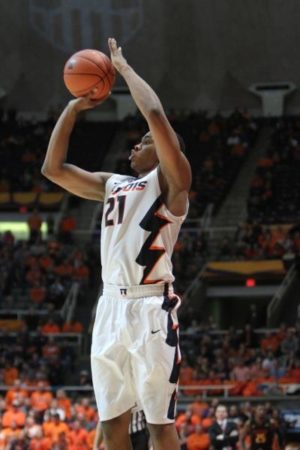
Midway through the 2015-16 NCAA basketball season, junior guard Malcolm Hill led the University of Illinois in minutes and points per game, averaging almost 19 points over 24 games. Malcolm had also been a basketball star at Belleville East High School in Belleville, Ill., named the St. Louis Post-Dispatch All-Metro Player of the Year in 2013. But, to achieve these heights, Malcolm had to overcome a serious vascular condition that threatened to end his young basketball career before it really started.
During the summer between his junior and senior high school years, Malcolm was playing in a summer basketball league. One morning when he woke up, his entire left arm was swollen and numb. His parents, Malcolm and Machanda Hill, sought immediate medical help and ended up taking Malcolm to a Metro East hospital. There, radiologists performed a venogram, which revealed a blood clot, and doctors administered a thrombolytic drug to dissolve the clot.
But the question remained: what had caused the clot? Vascular surgeons at the hospital suspected venous thoracic outlet syndrome (TOS), also called Paget-Schroetter Syndrome, in which thrombosis (clotting) occurs in the subclavian vein in the shoulder as a result of the vein being compressed. This often occurs as a result of vigorous activity. They referred Malcolm to Washington University vascular surgeon Robert Thompson, MD, who has treated hundreds of athletes and other patients with venous, arterial and neurogenic TOS.
“Emergency room physicians and other providers often overlook the possibility of a blood clot in TOS patients – they see a young, athletic person with a swollen arm and think the problem is muscular or allergy-related,” says Dr. Thompson. “Malcolm’s symptoms – dramatic swelling, numbness and bluish discoloration – are typical in venous TOS patients. Pain can also be present, although Malcolm did not report this.”
Dr. Thompson performed a paraclavicular thoracic outlet decompression, in which he removed the first rib and the muscles attached to it. He also traced the subclavian vein all the way under the collarbone to determine if there was scarring in the wall of the vein in addition to compression. The procedure uncovered a hidden stress fracture of the first rib, which may have caused the TOS.
When scarring was found, Dr. Thompson opened the vein through the scarred area and created a patch with a chemically treated cadaver vein to ensure good blood flow. He also created an arteriovenous (AV) fistula at the wrist, a temporary measure connecting the vein with an artery to further help with blood flow.
Malcolm’s condition and the procedure had created great anxiety for his parents because they had been told earlier their son could have passed out and died if he had continued to play with the clot. During the operation, Machanda Hill took a break and went to Dr. Thompson’s office, which has jerseys and other memorabilia from TOS patients displayed throughout the room. Dr. Thompson was in the office; having finished the decompression procedure, he was waiting for the cadaver vein to be prepared to complete the operation. Dr. Thompson explained the break in the surgery, and Machanda was reassured by his calm demeanor. She went back to the waiting room very hopeful for a good outcome.
Malcolm’s recovery went well, and he was able to play basketball his senior year of high school. He ended up as the All Time Leading Scorer for Belleville East, with 2004 career points.
“I felt good toward the middle of the season,” he says. “That’s when I started playing my best basketball.”
Malcolm hopes to play professional basketball after graduating from the University of Illinois, and he is majoring in cinema and media studies, so a broadcasting career might also be in his future.
Dr. Thompson sees no limits for Malcolm in his athletic career.
“Malcolm’s long-term prognosis is outstanding,” says Dr. Thompson. “At this point, he is a few years past this and has had no indication of recurrent symptoms. We have no reason to believe he will have a problem with it. The sky’s the limit for him.”